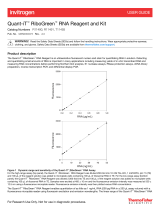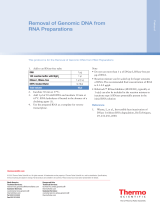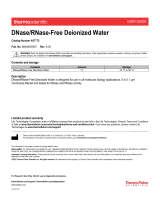Page is loading ...

Quant-iT™ PicoGreen™ dsDNA Reagent and Kit
Catalog Numbers P11496, P7589, P11495, P7581
Pub. No. MAN0001931 Rev. A.0
WARNING! Read the Safety Data Sheets (SDSs) and follow the handling instructions. Wear appropriate protective eyewear,
clothing, and gloves. Safety Data Sheets (SDSs) are available from thermofisher.com/support.
Product description
The Quant-iT™ PicoGreen™ dsDNA Reagent is an ultrasensitive fluorescent nucleic acid stain for quantitating double-stranded DNA
(dsDNA) in solution. Detecting and quantitating small amounts of DNA is important in many applications including synthesizing cDNA for
library production, purifying DNA fragments for subcloning, and quantifying DNA libraries for next-generation sequencing.
The Quant-iT™ PicoGreen™ dsDNA Reagent enables researchers to quantitate as little as 250 pg/mL of dsDNA (50 pg dsDNA in a 200 µL
assay volume) with a fluorescence microplate reader using fluorescein excitation and emission wavelengths. The linear detection range
of the Quant-iT™ PicoGreen™ assay in a standard fluorometer extends over more than 4 orders of magnitude in DNA concentration
(25 pg/mL to 1,000 ng/mL) with a single dye concentration (Figure 1). This linearity is maintained in the presence of several compounds
that commonly contaminate nucleic acid preparations, including salts, urea, ethanol, chloroform, detergents, proteins, and agarose.
Figure 1 Dynamic range and sensitivity of the Quant-iT™ PicoGreen™ dsDNA assay.
Calf thymus DNA was added to cuvettes containing the Quant-iT™ PicoGreen™ dsDNA Reagent diluted in 10 mM Tris-HCl, 1 mM EDTA, pH 7.5
(TE). The samples were excited at 480 nm and the fluorescence emission intensity was measured at 520 nm using a spectrofluorometer.
Fluorescence emission intensity was then plotted versus DNA concentration; the inset shows an enlargement of the results obtained with DNA
concentrations between 0 and 750 pg/mL.
The Quant-iT™PicoGreen™ dsDNA assay was developed to minimize the fluorescence contribution of RNA and single-stranded DNA
(ssDNA) (Figure 2). Using the Quant-iT™ PicoGreen™ dsDNA Reagent and the recommended assay protocol, researchers can quantitate
dsDNA in the presence of equimolar concentrations of ssDNA and RNA with minimal eect on the quantitation results.
USER GUIDE
For Research Use Only. Not for use in diagnostic procedures.

Figure 2 Fluorescence enhancement of the Quant-iT™ PicoGreen™ dsDNA Reagent upon binding dsDNA, ssDNA, and RNA.
Samples containing 500 ng/mL calf thymus DNA, M13 ssDNA, or E. coli ribosomal RNA were added to cuvettes containing the Quant-
iT™ PicoGreen™ dsDNA Reagent in TE. Samples were excited at 480 nm and the fluorescence emission spectra were collected using a
spectrofluorometer. Emission spectra for samples containing dye and nucleic acids, as well as for dye alone (baseline), are shown.
Contents and storage
Component
Quant-iT™ PicoGreen™ dsDNA
Reagents[1]
Quant-iT™ PicoGreen™ dsDNA Assay
Kits Concentration Storage[2]
Cat. No. P7581 Cat. No. P11495 Cat. No. P7589 Cat. No. P11496
Quant-iT™
PicoGreen™
dsDNA Reagent
(Component A)
1 mL 10 x 100 µL 1 mL 10 x 100 µL 200X in DMSO 2°C to 8°C[3]
Desiccate
Protect from light
20X TE
(Component B)
Not applicable Not applicable 25 mL 25 mL 200 mM Tris-HCl,
20 mM EDTA,
pH 7.5
≤30°C
Lambda DNA
standard
(Component C)
Not applicable Not applicable 1 mL 1 mL 100 µg/mL in TE 2°C to 8°C[3]
Number of labelings: 2,000 with an assay volume of 200 µL in a 96-well microplate format. The Quant-iT™ PicoGreen™ dsDNA assay can be
adapated for use in cuvettes or 384-well microplates.
Approximate fluorescence excitation/emission maxima: 502/523 nm, bound to nucleic acid.
[1] Stand-alone reagents do not include Components B and C.
[2] When stored as directed, products are stable for at least 6 months.
[3] For long-term storage, the Quant-iT™ PicoGreen™ dsDNA Reagent and lambda DNA standard can be stored at ≤–20°C.
Required materials not supplied
• Nuclease-free pipettors and tips
• Nuclease-free water
• Microplates for Fluorescence-based Assays, 96-well (Cat. No. M33089)
Prepare the assay buer
Prepare a 1X TE working solution by diluting the concentrated buer 20‑fold with sterile, distilled, DNase-free water.
IMPORTANT! TE buer (10 mM Tris-HCl, 1 mM EDTA, pH 7.5) is used to prepare the Quant-iT™ PicoGreen™ dsDNA Reagent working
solution, and to dilute the dsDNA standards and samples. Because the Quant-iT™ PicoGreen™ dye is an extremely sensitive detection
reagent for dsDNA, the TE solution used must be free of contaminating nucleic acids. The 20X TE buer included in the Quant-iT™
PicoGreen™ dsDNA Assay Kit is certified to be nucleic acid–free and DNase-free.
2 Quant-iT™ PicoGreen™ dsDNA Reagent and Kit User Guide

Prepare the reagent
On the day of the experiment, allow the Quant-iT™ PicoGreen™ dsDNA Reagent to warm to room temperature before opening the vial, then
prepare an aqueous working solution of the Quant-iT™ PicoGreen™ dsDNA Reagent by diluting the concentrated DMSO solution 200-fold
in TE. For microplate assays of a total 200 µL assay volume, you need 100 µL of the Quant-iT™ PicoGreen™ dsDNA Reagent working
solution per sample.
For example, to prepare enough working solution to assay 100 samples in 200 µL volumes, add 50 µL Quant-iT™ PicoGreen™ dsDNA
Reagent to 9.95 mL TE.
Note: We recommend preparing this solution in a plastic container rather than glass, as the reagent may adsorb to glass surfaces. Protect
the working solution from light, as the Quant-iT™ PicoGreen™ dsDNA Reagent is susceptible to photodegradation. For best results, use
the working solution within a few hours of preparation.
Prepare the DNA standard curve
1. Prepare a 2 µg/mL stock solution of dsDNA in TE. Determine the DNA concentration on the basis of absorbance at 260 nm (A260) in
a cuvette with a 1 cm pathlength; an A260 of 0.04 corresponds to 2 µg/mL dsDNA solution.
The lambda DNA standard, provided at 100 µg/mL in the Quant-iT™ PicoGreen™ dsDNA Assay Kit, is diluted 50‑fold in TE to make
the 2 µg/mL working solution. For example, 3 µL of the DNA standard mixed with 147 µL of TE is sucient for the standard curve
described in step 2.
Note: For a standard curve, we commonly use bacteriophage lambda or calf thymus DNA, although any purified dsDNA preparation
may be used. It is sometimes preferable to prepare the standard curve with DNA similar to the type being assayed; e.g., long
or short linear DNA fragments when quantitating similar-sized restriction fragments or plasmid when quantitating plasmid DNA.
However, most linear dsDNA molecules yield approximately equivalent signals, regardless of fragment length.
Note: The dsDNA solution used to prepare the standard curve should be treated the same way as the experimental samples and
should contain similar levels of contaminants. See “Eects of common contaminants” on page 4 for a list of contaminants tested
in the Quant-iT™ PicoGreen™ assay.
2. For the high-range standard curve from 10 ng/mL to 1 µg/mL, dilute the 2 µg/mL DNA stock solution into microplate wells as shown
in Table 1. For the low-range standard curve from 250 pg/mL to 25 ng/mL, dilute the 2 µg/mL DNA solution (prepared in step 1)
40-fold in TE to yield a 50 ng/mL DNA stock solution, then prepare the dilution series shown in Table 2.
Table 1 Protocol for preparing a high-range standard curve.
Volume of TE buer Volume of 2 µg/mL DNA stock Volume of diluted Quant-iT™
PicoGreen™ dsDNA Reagent
Final DNA concentration in
assay
0 µL 100 µL 100 µL 1 µg/mL
90 µL 10 µL 100 µL 100 ng/mL
99 µL 1 µL 100 µL 10 ng/mL
100 µL 0 µL 100 µL blank
Table 2 Protocol for preparing a low-range standard curve.
Volume of TE buer Volume of 50 ng/mL DNA stock Volume of diluted Quant-iT™
PicoGreen™ dsDNA Reagent
Final DNA concentration in
assay
0 µL 100 µL 100 µL 25 ng/mL
90 µL 10 µL 100 µL 2.5 ng/mL
99 µL 1 µL 100 µL 250 pg/mL
100 µL 0 µL 100 µL blank
3. Add 100 µL of the aqueous working solution of the Quant-iT™ PicoGreen™ dsDNA Reagent (prepared in “Prepare the reagent” on
page 3) to each well. Mix well and incubate for 2–5 minutes at room temperature, protected from light.
4. Measure the sample fluorescence using a fluorescence microplate reader and standard fluorescein wavelengths (excitation
∼480 nm, emission ∼520 nm).
Note: To ensure that the sample readings remain in the detection range, the instrument’s gain should be set so that the sample
containing the highest DNA concentration yields a fluorescence intensity near the microplate reader’s maximum. For optimal
Quant-iT™ PicoGreen™ dsDNA Reagent and Kit User Guide 3

detection sensitivity, the instrument gain can be increased for the low-range assay relative to the high-range assay. To minimize
photobleaching eects, keep the time for fluorescence measurement constant for all samples.
5. Subtract the fluorescence value of the reagent blank from that of each of the samples. Use corrected data to generate a standard
curve of fluorescence versus DNA concentration (Figure 1).
Analyze samples
1. Dilute the experimental DNA solution in TE to a final volume of 100 μL in microplate wells.
Note: You can alter the amount of sample diluted, provided that the final volume remains 100 μL. A higher dilution of the
experimental sample may diminish the interfering eect of certain contaminants. However, extremely small sample volumes should
be avoided because they are dicult to pipet accurately. See “Eliminate single-stranded nucleic acids from samples” on page 5
for information on eliminating RNA and ssDNA from the sample.
2. Add 100 μL of the aqueous working solution of the Quant-iT™ PicoGreen™ dsDNA Reagent to each sample. Incubate for 2–5 minutes
at room temperature, protected from light.
3. Measure the fluorescence of the samples using the same instrument parameters used to generate the standard curve (see step 4).
To minimize photobleaching eects, keep the time for fluorescence measurement constant for all samples.
4. Subtract the fluorescence value of the reagent blank from that of each of the samples. Determine the DNA concentration of the
sample from the standard curve generated in “Prepare the DNA standard curve” on page 3.
5. The assay can be repeated using a dierent dilution of the sample to confirm the quantitation results.
Eects of common contaminants
The Quant-iT™ PicoGreen™ assay remains linear in the presence of several compounds that commonly contaminate nucleic acid
preparations, although the signal intensity may be aected (Table 3). For the highest accuracy, the standards should be prepared under
the same conditions as the experimental samples and contain similar levels of contaminants.
Table 3 Eects of common contaminants on the signal intensity of the assay.
Compound Maximum acceptable concentration % Signal change[1]
Salts
Ammonium acetate 50 mM 3% decrease
Sodium acetate 30 mM 3% increase
Sodium chloride 200 mM 30% decrease
Zinc chloride 5 mM 8% decrease
Magnesium chloride 50 mM 33% decrease
Urea 2 M 9% increase
Organic solvents
Phenol 0.1% 13% increase
Ethanol 10% 12% increase
Chloroform 2% 14% increase
Detergents
Sodium dodecyl sulfate 0.01% 1% decrease
Triton™ X-100 0.1% 7% increase
Proteins
Bovine serum albumin 2% 16% decrease
IgG 0.1% 19% increase
4 Quant-iT™ PicoGreen™ dsDNA Reagent and Kit User Guide

Compound Maximum acceptable concentration % Signal change[1]
Other compounds
Polyethylene glycol 2% 8% increase
Agarose 0.1% 4% increase
[1] The compounds were incubated at the indicated concentrations with Quant-iT™ PicoGreen™ reagent in the presence of 500 ng/mL calf thymus DNA. All samples were assayed in
a final volume of 200 µL in 96‑well microplates using a fluorescence microplate reader. Samples were excited at 485 nm and fluorescence intensity was measured at 520 nm.
Eliminate single-stranded nucleic acids from samples
Using the Quant-iT™ PicoGreen™ dsDNA Assay Kit, dsDNA can be quantitated in the presence of equimolar concentrations of single-
stranded nucleic acids with minimal interference. Table 4 shows the concentrations of RNA or ssDNA that, for a given dsDNA
concentration, result in less than a 10% change in the signal intensity using the Quant-iT™ PicoGreen™ assay protocol. Fluorescence
due to the Quant-iT™ PicoGreen™ dsDNA Reagent binding to RNA at high concentrations can be eliminated by treating the sample with
DNase-free RNase. The use of RNase A/RNase T1 with S1 nuclease will eliminate all single-stranded nucleic acids and ensure that the
entire sample fluorescence is due to dsDNA.
Table 4 Sensitivity of the Quant-iT™ PicoGreen™ dsDNA assay for quantitating dsDNA in the presence of single-stranded nucleic
acids.
dsDNA[1] RNA (amount relative to dsDNA) ssDNA (amount relative to dsDNA)
1 µg/mL 10 µg/mL (10X) 300 ng/mL (0.3X)
500 ng/mL 500 ng/mL (1X) 50 ng/mL (0.1X)
10 ng/mL 100 ng/mL (10X) 30 ng/mL (3X)
5 ng/mL 50 ng/mL (10X) 15 ng/mL (3X)
100 pg/mL 1 ng/mL (10X) 1 ng/mL (10X)
50 pg/mL 500 pg/mL (10X) 500 pg/mL (10X)
[1] For several concentrations of dsDNA, we show the concentration of RNA or ssDNA that results in no more than a 10% increase in the sample’s signal intensity.
Related products
Table 5 Bulk Reagents and Kits
Product Quantity Cat. No.
Quant-iT™ PicoGreen™ dsDNA Assay Kit 1 mL assay kit
10 x 100 µL
P7589
P11496
Quant-iT™ PicoGreen™ dsDNA Reagent 1 mL reagent
10 x 100 µL
P7581
P11495
TE Buer (20X), RNase-free 100 mL T11493
Quant-iT™ RiboGreen™ RNA Assay Kit 1 mL assay kit R11490
Quant-iT™ RiboGreen™ RNA Reagent 1 mL reagent R11491
Quant-iT™ RediPlate™ 96 RiboGreen™ RNA
Quantitation Kit 1 plate R32700
Quant-iT™ OliGreen™ ssDNA Assay Kit 1 mL assay kit O11492
Quant-iT™ OliGreen™ ssDNA Assay Reagent 1 mL reagent O7582
Quant-iT™ PicoGreen™ dsDNA Reagent and Kit User Guide 5

Table 6 Microplate Reader Assays
Product Dynamic Range Quantity Cat. No.
Quant-iT™ 1X dsDNA Assay Kit,
High Sensitivity 200 pg−100 ng 1,000 reactions Q33232
Quant-iT™ 1X dsDNA Assay Kit,
Broad-Range 4 ng−2 μg 1,000 reactions Q33267
Quant-iT™ DNA Assay Kit, High
Sensitivity 200 pg−100 ng 1,000 reactions Q33120
Quant-iT™ DNA Assay Kit, Broad-
Range 4 ng−1 μg 1,000 reactions Q33130
Quant-iT™ RNA Assay Kit 5−100 ng 1,000 reactions Q33140
Quant-iT™ RNA Reagent 5−100 ng 1,000 reactions Q32884
Quant-iT™ RNA Assay Kit, Broad
Range 20 ng−1 μg 1,000 reactions Q10213
Quant-iT™ RNA XR Assay Kit 200 ng−10 μg 1,000 reactions Q33225
Quant-iT™ microRNA Assay Kit 1−100 ng 1,000 reactions Q32882
Quant-iT™ Protein Assay Kit 250 ng−5 μg 1,000 reactions Q33210
Microplates for Fluorescence-based
Assays, 96-well — 10 plates M33089
Limited product warranty
Life Technologies Corporation and/or its aliate(s) warrant their products as set forth in the Life Technologies' General Terms and
Conditions of Sale at www.thermofisher.com/us/en/home/global/terms-and-conditions.html. If you have any questions, please
contact Life Technologies at www.thermofisher.com/support.
Life Technologies Corporation | 29851 Willow Creek Road | Eugene, Oregon 97402 USA
For descriptions of symbols on product labels or product documents, go to thermofisher.com/symbols-definition.
The information in this guide is subject to change without notice.
DISCLAIMER: TO THE EXTENT ALLOWED BY LAW, THERMO FISHER SCIENTIFIC INC. AND/OR ITS AFFILIATE(S) WILL NOT BE LIABLE FOR SPECIAL, INCIDENTAL, INDIRECT,
PUNITIVE, MULTIPLE, OR CONSEQUENTIAL DAMAGES IN CONNECTION WITH OR ARISING FROM THIS DOCUMENT, INCLUDING YOUR USE OF IT.
Revision history: Pub. No. MAN0001931
Revision Date Description
A.0 15 March 2022 The format and content were updated. The version numbering was reset to A.0 in
conformance with internal document control.
1.00 10 June 2008 New document for the Quant-iT™ PicoGreen™ dsDNA Assay Kit and Quant-iT™ PicoGreen™
dsDNA Reagent.
Important Licensing Information: These products may be covered by one or more Limited Use Label Licenses. By use of these products, you accept the terms and conditions of all
applicable Limited Use Label Licenses.
©2022 Thermo Fisher Scientific Inc. All rights reserved. All trademarks are the property of Thermo Fisher Scientific, Inc. and its subsidiaries unless otherwise specified.
thermofisher.com/support | thermofisher.com/askaquestion
thermofisher.com
15 March 2022
/











